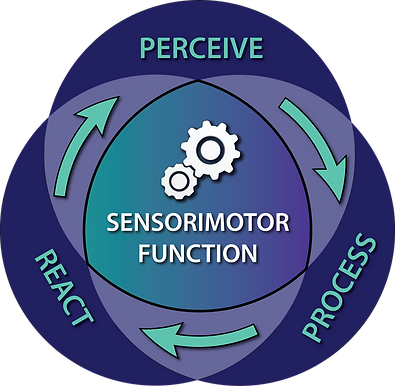Rehabilitation typically involves manually administered physical therapy (PT) strategies that target dysfunction with repetitious stimulation and exercise routines. However, manually administered PT has inherent unavoidable physical limitations, can take a long time to achieve appreciable gains, and can only go so far.
GyroStim's powerful automation and computer controlled therapeutic profiles overcome the limitations of manually administered PT. GyroStim is uniquely capable of administering multiple types of therapeutic stimulation, simultaneously, which helps synchronize, coordinate, and improve the complex interactions occurring throughout the sensorimotor system.
GyroStim is clinically proven to be an efficient and effective means for rehabilitation of chronic symptoms from vestibular dysfunction resulting from concussion, TBI, stroke, and many other neurological conditions.
Concussion, TBI, stroke, and many other neurological conditions can disrupt the brain's structural connections and functional abilities to process intrinsic and extrinsic stimuli, which can result in vestibular dysfunction and a wide range of persistent symptoms.
-
Headache
-
Dizziness
-
Nausea
-
Brain Fog
-
Anxiety
-
Migraine
-
Poor Memory
-
Depression
-
Sleep Disorder
-
Chronic Fatigue
-
Sensitivity to Light
-
Difficulty Reading
-
Unsteady Gait
-
Poor Spatial Awareness
-
Emotional Fragility
-
Motion Sensitivity
-
Mental Confusion
-
Sensitivity to Noise
Sensorimotor Function
The sensorimotor system is the complex network of sensory input and motor output signals running throughout your body that interconnect with your brain.
This system allows you to perceive, process, and react to what is happening around you:
-
PERCEIVE: Detailed information about what is happening in the world around you is sensed through the eyes (vision), ears (hearing), vestibular system (balance), and other parts of the sensory nervous system and transmitted to the brain.
-
PROCESS: Sensory information received and distributed throughout the brain, igniting a cascade of processing activity as the brain goes to work, forming an appropriate response to the perceived sensory information.
-
REACT: Once sensory information has been processed, you may react with any combination of thoughts, verbal response, and voluntary or involuntary motor commands which are fired throughout the brain and body to execute the intended reaction.
Principles of Operation
Fundamental principles of operation are:
-
Automation
-
Whole-Body Multi-Axis Rotation
-
Data-Driven Therapy Progression
-
Relative Intensity Protocols
-
Interactive Multisensory Stimulation
Whole-body multi-axis rotation generates comprehensive simultaneous stimulation to all sensory systems located throughout the human body.
Automation also allows for data-driven treatment strategies. Qualitative and quantitative data is used for clinical decision support throughout the treatment session. Data provides the clinician with critical information, allowing the therapy to be advanced at a pace that is optimized and appropriate for each patient.
Treatment advances via a library of relative intensity motion protocols that serves as a framework for data-driven progression of individualized treatment programs.
Throughout the treatment, interactive multisensory stimulation is presented in a variety of cognitive and physical challenges during whole-body rotation.

Copyright 2024 UltraThera Technologies, Inc.



_edited.jpg)


